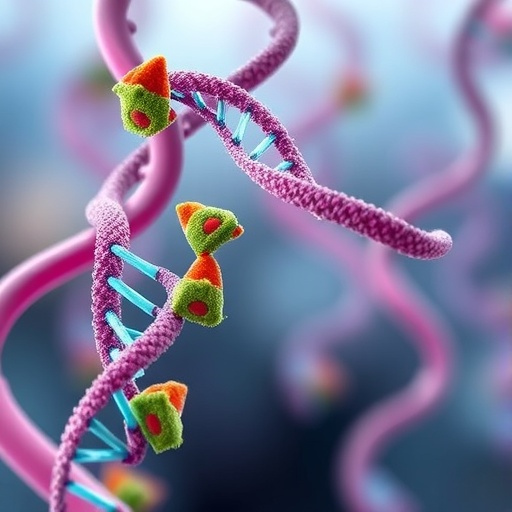In a groundbreaking stride for genetic engineering, researchers have unveiled a novel approach that significantly enhances the efficacy of suppressor transfer RNAs (sup-tRNAs) using prime editing technology. This advancement paves the way for versatile, disease-agnostic genome editing strategies that could revolutionize the treatment of genetic disorders. The study, recently published in Nature, explores mutations within the tRNA molecule itself to boost sup-tRNA functionality, delivering unprecedented precision and efficiency in genome modification.
Suppressor tRNAs serve as critical tools in the field of gene editing by enabling cells to read through premature stop codons, thus restoring the production of functional proteins. However, optimizing these molecules for therapeutic applications has remained a formidable challenge due to the complex interplay between tRNA structure, cellular machinery, and the repair mechanisms that govern genomic stability. The latest research addresses these hurdles by systematically introducing mutations directly into sup-tRNAs to enhance their performance post-prime editing.
The team began their investigation by selecting three candidate human sup-tRNAs—tRNA-Arg-CCT-4-1, tRNA-Tyr-GTA-2-1, and tRNA-Leu-TAA-4-1—alongside a mouse ortholog, tRNA-Leu-TAA-2-1. They engineered comprehensive lentiviral libraries that incorporated every conceivable single-nucleotide substitution, single-base deletion, and paired-base modification within the tRNA sequences. This high-throughput approach enabled a granular exploration of structure-function relationships within the sup-tRNAs, facilitating identification of mutations that could amplify their suppressive activity.
Upon transducing these lentiviral libraries into a reporter cell line, which allowed precise quantification of sup-tRNA function, the researchers observed that most mutations diminished tRNA performance. Deletions, in particular, were largely detrimental, underscoring the structural sensitivity of tRNAs to nucleotide loss. However, a notable subset of single-nucleotide variants and paired-base substitutions led to measurable improvements in sup-tRNA efficacy. This highlights the delicate balance between preserving tRNA integrity and introducing beneficial alterations to optimize function.
Beyond optimizing sup-tRNA activity, the team aimed to devise mutations that could circumvent intrinsic cellular mismatch repair (MMR) pathways. By identifying silent mutations that evade MMR detection, they sought to enhance the durability and effectiveness of prime editing outcomes. This strategy also addresses the issue of prime editor rebinding to the repaired locus, which can impede editing precision. Through these refined mutations, the researchers demonstrated enhanced genomic editing fidelity by reducing unwanted cellular responses.
The effect of beneficial mutations discovered in the tRNA-Leu-TAA-4-1 variant was further corroborated on paralogous tRNA family members, including tRNA-Leu-TAA-1-1, -2-1, and -3-1. This cross-applicability suggests a potential for broad utility of these optimized tRNAs in various genomic contexts and across species. Such versatility articulates the promise for these engineered sup-tRNAs to be tailored for a wide spectrum of therapeutic targets.
Prime editing itself is a relatively nascent genome editing technique that leverages a fusion of a catalytically impaired Cas9 and a reverse transcriptase. It allows highly specific nucleotide modifications without introducing double-strand breaks, thereby reducing off-target effects and enhancing cellular safety profiles. Integrating sup-tRNAs into this framework further expands the capability to correct nonsense mutations—key culprits in many genetic diseases.
The implications of this research extend far beyond the bench. By developing sup-tRNAs that can be seamlessly integrated into prime editing workflows and resist cellular repair obstacles, therapeutic gene correction approaches become more feasible and efficient. This could transform treatment paradigms for a host of disorders caused by premature stop codons, such as cystic fibrosis, Duchenne muscular dystrophy, and various inherited retinal diseases.
Importantly, the systematic mutational approach taken by the researchers provides a blueprint for future engineering of noncoding RNAs in gene therapy applications. Rather than relying solely on alterations in the anticodon region, this study underscores the value of probing and optimizing additional structural elements within tRNAs to unlock enhanced functionality.
This work also contributes vital insights into the mechanistic underpinnings of tRNA performance within the complex cellular milieu. Understanding the nuanced influence of nucleotide substitutions and deletions on tRNA stability, folding, and interaction with ribosomes and editing complexes is critical for designing next-generation gene editing tools.
As prime editing technologies continue their rapid evolution, the introduction of sup-tRNAs with improved activity and MMR evasion capabilities could mitigate current limitations, such as partial editing efficiency and undesired genomic outcomes. The integration of these enhanced molecular components stands to elevate the precision and durability of gene correction protocols in clinical settings.
Looking forward, further investigation into the long-term stability and immunogenicity of these optimized sup-tRNAs in vivo will be essential before broader therapeutic implementation. Nonetheless, this pioneering study marks a monumental advance in the genetic toolkit available to researchers and clinicians alike.
The convergence of synthetic biology, RNA engineering, and prime editing at the heart of this research exemplifies the future of personalized medicine—where tailored molecular interventions can correct the very root causes of genetic diseases with remarkable accuracy and minimal side effects. The findings illuminate a promising pathway toward realizing the full therapeutic potential of genome editing.
Subject of Research:
Gene editing enhancement through engineered suppressor tRNAs integrated with prime editing technology.
Article Title:
Prime editing-installed suppressor tRNAs for disease-agnostic genome editing.
Article References:
Pierce, S.E., Erwood, S., Oye, K. et al. Prime editing-installed suppressor tRNAs for disease-agnostic genome editing. Nature (2025). https://doi.org/10.1038/s41586-025-09732-2
DOI:
https://doi.org/10.1038/s41586-025-09732-2
Keywords:
Prime editing, suppressor tRNAs, genome editing, nucleotide substitutions, mismatch repair evasion, lentiviral libraries, genetic therapy, noncoding RNA engineering
Tags: cellular machinery in gene editingdisease-agnostic treatmentsenhancing sup-tRNA functionalitygenetic disorder therapiesgenetic engineering advancementsgenome editing strategieshigh-throughput tRNA researchmutations in tRNA moleculesoptimizing therapeutic tRNAsprecision genome modificationprime editing technologysuppressor transfer RNAs





